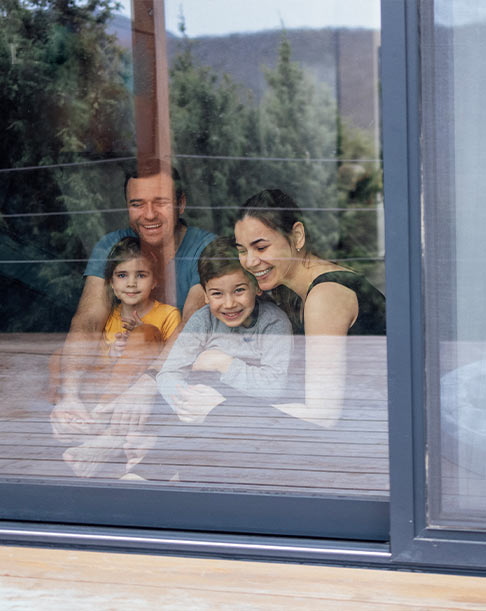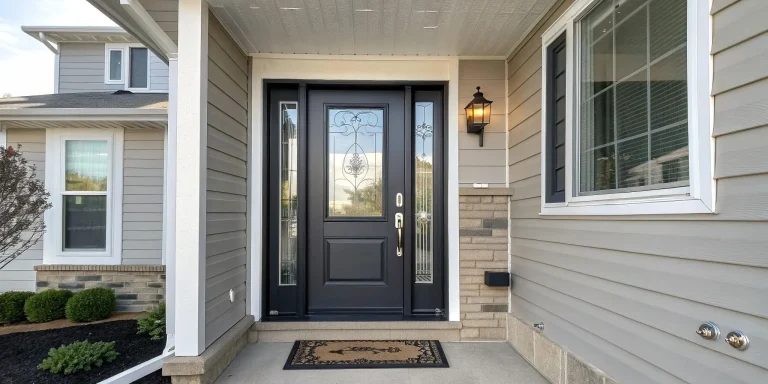These innovative doors utilize precision sliding mechanisms that maximize space efficiency while providing adjustable ventilation control. The integrated top and bottom vents feature weather-sealed louvers that can be independently adjusted for optimal airflow without compromising the door’s security or thermal performance. The sliding system operates on stainless steel tracks with sealed ball bearings for smooth, quiet operation even in sub-zero temperatures. That matters in Calgary, where –35°C winter nights demand reliable operation without freezing mechanisms. The sealed bearing system and reinforced tracks won’t bind or stick during rapid temperature changes, ensuring consistent ventilation control when you need it most – whether managing moisture from melting snow or capturing cool evening breezes during summer heat waves.
Combining classical elegance with modern ventilation technology, these doors feature multiple tempered glass panels with integrated venting systems seamlessly built into the door framework. The venting mechanisms are strategically positioned within the mullion bars and frame structure, maintaining the door’s traditional aesthetic while providing controlled airflow. Multi-chambered frame construction with thermal breaks prevents condensation formation around the venting components. This design is crucial in Calgary’s climate, where interior-exterior temperature differentials can exceed 50°C during winter months. The thermal break technology ensures that vent components won’t frost over or create cold bridges, maintaining both ventilation functionality and energy efficiency throughout Calgary’s harsh winters and hot summers.
Contemporary pivot doors rotate on precision-engineered pivot hardware while incorporating discreet ventilation elements that complement their modern aesthetic. The pivot system distributes the door’s weight across heavy-duty floor and header pivots, allowing for larger door sizes and seamless operation. Venting components are integrated into the door’s thickness or frame perimeter, maintaining clean sight lines while providing adjustable airflow control. The pivot mechanism features sealed components and weather-resistant finishes to withstand extreme conditions. This robust construction is essential in Calgary, where powerful Chinook winds can generate gusts exceeding 120 km/h. The pivot system’s low profile and multiple contact points distribute wind loads evenly, preventing door distortion and maintaining proper seal contact for consistent weather protection and ventilation performance.
Featuring adjustable horizontal slats constructed from weather-resistant materials, these doors provide maximum ventilation control while maintaining privacy and security. Each louver blade operates independently through a precision linkage system, allowing fine-tuned airflow adjustment. The slats feature interlocking edges and weather seals to prevent water infiltration when closed, while providing excellent air circulation when opened. Reinforced frame construction accommodates the operational stresses of the louver mechanism. Calgary’s extreme weather variations make this adjustability invaluable – from managing spring humidity to capturing cooling breezes during summer heat, while providing complete closure during winter storms. The robust linkage system operates smoothly even after repeated freeze-thaw cycles, ensuring reliable ventilation control year-round.
Traditional raised panel doors enhanced with strategically placed ventilation components that maintain the door’s classic appearance while adding functional airflow capability. Venting panels can be positioned in upper, lower, or both sections of the door, featuring weather-sealed louvers or adjustable grilles that complement the door’s design aesthetic. The panel construction utilizes engineered materials that resist warping and dimensional changes while accommodating the venting hardware. Panel-to-frame connections are reinforced to handle operational stresses. This traditional styling with modern functionality suits Calgary’s established neighborhoods where architectural consistency matters, while the ventilation features address the practical needs of managing indoor air quality during the city’s long heating season and brief but intense summer periods.






















